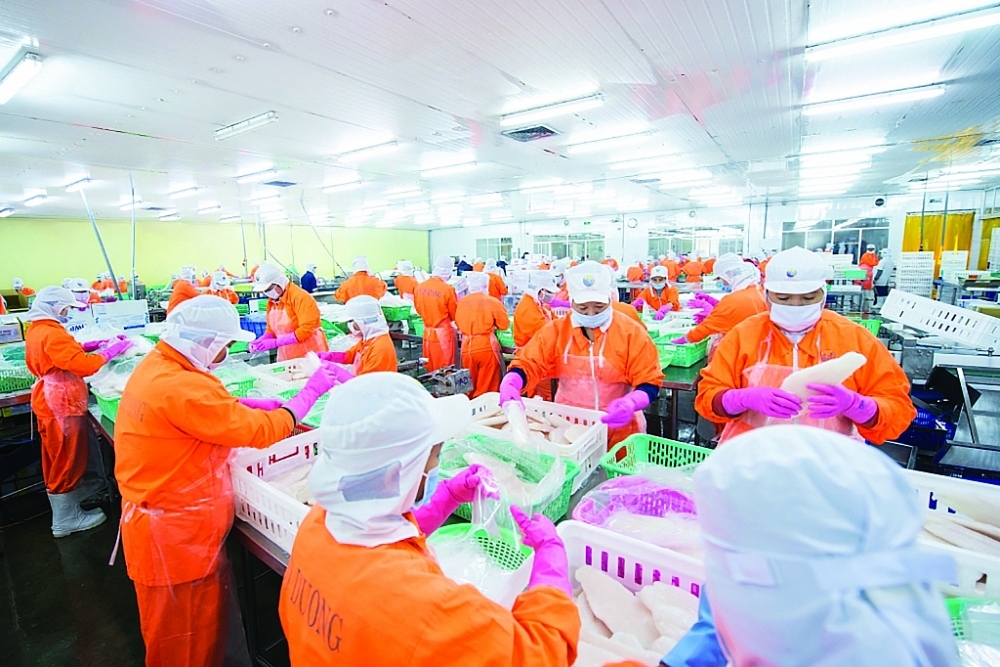VASEP proposes to remove obstacles for seafood exports in the second half of the year
Making comments about the challenges facing seafood exporters in the second half of the year, leaders of the Vietnam Association of Seafood Exporters and Producers (VASEP) proposed solutions to remove difficulties and support seafood production and export for enterprises.
 |
|
Processing seafood for export at Nam Viet Company. Photo: provided by the company |
Costs soar
VASEP said that seafood enterprises are bearing a lot of increased costs, leading to input costs for production, high product prices, directly affecting their competitiveness aquatic products and industries.
According to calculations by VASEP, since 2020, amid "port congestion" due to the Covid-19 pandemic and the price of petrol and oil increasing, it is already difficult to place empty containers to load export goods. The industry has to face skyrocketing fares on most routes, with an increase of four to five times.
As of June 2022, it has decreased, to export a forty-foot container through the East Coast of the United States (Florida), the freight rate was about US$16,400/container, including the cost of road transportation from factories in the provinces to Ho Chi Minh City (accounting for more than 60%), with an average price of VND400-410 million/container.
Experiencing twelve price increases since the beginning of the year, 40-50% of fishing vessels have been ashore, causing input materials for processing plants to decrease by 70-80% compared to before.
According to statistics of Hon Ro fishing port (Khanh Hoa), by July 2022, more than 90% of fishing boats that were not supported had stopped operating. The volume of seafood arriving at the port also decreased by 30-40%, mainly from short-term fishing vessels.
Due to a sharp decrease in domestic raw materials, seafood processing factories also faced difficulties. Enterprises were forced to increase the source of imported raw materials but did not have enough for processing.
The increase in gasoline prices pushes the cost of road transport and logistics to increase by 10-20%. This is a difficult problem for seafood businesses in the context that the world seafood market has recovered after Covid-19 and is experiencing strong competition from other export sources.
VASEP recommendations
A difficulty for seafood processing enterprises is the lack of processing materials.
According to VASEP's assessment, the source of raw materials from farming accounts for 70% for export processing. Therefore, businesses need to expand concentrated farming areas to increase raw materials for export processing. However, localities are urbanizing, so changes in land planning for production and land use are a big challenge for seafood enterprises and aquaculture farmers.
In order to solve the problems, VASEP said that it is necessary to accelerate the amendment of the Land Law, with special attention to the issues of land accumulation, land use regulations, and land planning for the development of the fisheries sector. Governments and localities also need policies to develop and expand concentrated aquaculture areas.
Regarding imports, VASEP said that policies to encourage the import of aquatic materials for production and export are still lacking, and procedures for import are difficult and entangled.
On the basis of the Fisheries Development Strategy to 2030 approved by the Prime Minister in 2021, VASEP proposes to the Government to issue regulations and policies to encourage the import of aquatic materials for export production and processing.
This will help Vietnam take advantage of modern processing capacity, skilled workers and achieve the goal of becoming a large "processing factory" of the world's seafood. For at least ten years, clean and legal raw materials have been increasingly imported into Vietnam to meet orders and jobs when seasonal or world demand increases.
In addition, the procedure for certification of the origin of exploited aquatic products is still inadequate. Therefore, businesses still have problems when using certified raw materials.










